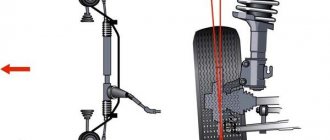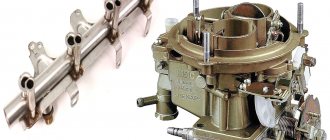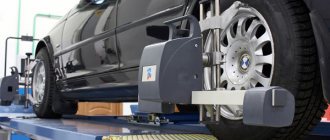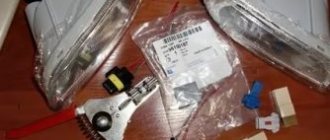Steering damper for UAZ Patriot: affordable driving comfort
All lucky people who have purchased a UAZ Patriot know firsthand the problem of steering vibration and horizontal vibrations of the front suspension. When the speed increases above 60 km per hour, they become more and more distinct. There are several most pronounced and popular “symptoms”:
- the car has become more difficult to drive;
- directional yaw of wheels;
- When hitting bumps, the steering wheel can clearly feel impacts.
These problems negatively affect the steering design and suspension in conjunction with the tires. These technological shortcomings can be solved by installing a steering damper (from the English “damp”, which means to extinguish). Car dealerships themselves offer to purchase it when purchasing a car.
Steering damper for UAZ Patriot
A little theory about the steering damper A steering damper (steering shock absorber) is a device similar in design to a shock absorber that dampens (the name damper from the English to damp) unwanted vibrations of the steering elements.
On the one hand, the steering damper can absorb sudden, unwanted vibration of the steering rods in the horizontal plane and thus prevent the development of this vibration. Under normal conditions, a good damper should be simply invisible and should not create additional steering resistance. But he must always be on guard in order to extinguish sudden fluctuations at any moment. Of course, a damper cannot completely damp out vibrations, but it can significantly reduce their frequency and amplitude. The operating principles of the steering damper completely replicate those inherent in modern shock absorbers. In a simplified model, everything looks like this. The design is based on a container filled with oil and a movable partition dividing the container into two chambers. There are also special openings (valves), the size of which is adjustable. The partition moves inside the container, thus changing the volumes of the two chambers and forcing the oil to circulate through the holes. The amount of damping is adjusted by changing the size of the holes (sometimes also their number) through which the oil passes: the smaller the hole, the higher the degree of damping and vice versa. Depending on the design of the damper, the partition can be connected either to a rod that moves back and forth (telescopic damper, its use is SUVs, sports cars, special equipment - combination, as an actuator), or to a rotating axis (rotary damper, its Most often used in off-road motorcycles and sportbikes). Today, these two types of steering dampers are used: telescopic (Rancho, Pro-comp, Tough-Dog, HyperPro, Matris, Toby) and rotary (Scotts, WSC, WER, Ohlins). Telescopic shock absorbers are very similar to conventional shock absorbers: a rod on which a piston is attached moves inside the cylindrical damper body. It performs the function of that very moving “partition”. Telescopic dampers are installed in different ways (depending on the specific vehicle model and the selected mounting kit), but most often - along the steering elements. Rotary dampers are completely different from their telescopic counterparts, although they work on the same principle. Such dampers have a much more robust design and are much more resistant to damage from falls (telescopic dampers fail with any more or less serious impact), so they have proven themselves primarily on off-road motorcycles. This does not prevent them, however, from being used with equal success on sportbikes. How necessary is a damper for UAZ Patriot?
The main purpose of steering dampers for an off-road vehicle is to improve handling characteristics on all types of road surfaces and off-road, by reducing the level of vibration in the steering, and as a result, reducing driver fatigue.
In addition, after installing a steering damper, the wear pattern of the tires becomes more uniform, which again improves tire grip in difficult conditions. The steering becomes more informative, and directional stability at high speeds improves (for UAZ-Patriots this becomes noticeable after 70 km/h). An installed steering damper helps protect external suspension components from damage off-road. Driving becomes more comfortable and safe. The steering damper can be selected depending on the required stiffness and operating conditions. The damper is, of course, necessary for modern extreme “liters”, “tons” and “all-terrain vehicles”, provided that it is installed and configured correctly - an element of your safety, and it hardly makes sense to save on it. Installing a steering damper on a UAZ
We present to your attention an example of installing a steering damper on a UAZ-Patriot.
Correct installation of the steering damper is the key to its long and flawless operation. A feature of the installation of the steering damper is to ensure small angles of divergence of the geometry between the axis of the damper and the axis of the steering rod on which it is installed. The smaller the fracture angles, the less the load on the damper silent blocks. The photographs on this page show the installation of the steering damper on the lower tie rod, which ensures more correct operation of the damper, but with this option you should be careful off-road - the following cases may occur:
Steering Damper
Another installation option, not shown here, is to install a damper on the upper tie rod. The damper is less effective, but more protected.
How the device works
In appearance, this design is similar to a shock absorber.
Moreover, their operating principle is also similar. The damper looks like a cylinder containing a piston and oil. The piston has holes for oil to pass through. Moving in the cylinder, it provokes the flow of working fluid between the internal chambers of the device. The movement of the liquid smoothly slows down the stroke of the piston, thereby smoothly dampening vibrations. Dampers come in single- and double-acting types. Their difference is that the first option has a spring return mechanism. This device, according to its purpose, helps absorb shocks that come from the wheels to the steering wheel. After all, when this happens, the driver’s fingers feel all the unpleasant vibrations, and it is simply necessary to smooth them out for normal driving. When driving on a bumpy road, the driver has to directly “catch” the steering wheel in order to keep the car on a given course. You can learn more about the appearance of yaw in the UAZ Patriot from this video. The equipment does not completely eliminate steering wheel wobble, but it significantly dampens vibrations. Another damper on the UAZ Patriot helps the steering wheels return to their original (zero) position after turning. But this does not apply to the advantages of the device, since driving a car becomes a little peculiar. Vibrations on steering rods are familiar to these cars, because they are SUVs and often travel over rough terrain, where this is felt especially strongly. You can drive on asphalt roads relatively calmly, but in harsh conditions you cannot do without a damper. This mainly applies to country travel on domestic broken dirt roads and field roads. But you need to choose the right one for your car so that everything works without problems, and install it correctly.
Changing front and rear dampers with your own hands
Some novice car enthusiasts have a logical question: why do they distinguish and report separately on the front and rear suspensions of a car? And what are the specifics of the operation of the front and rear suspension dampers?
The short answer is that, in principle, everything is easy: the differences are that the front suspension dampers often fail than the rear dampers, which is why they are different. And, therefore, such a task as replacing the shock absorbers of both suspensions must be considered separately. The front part of the car performs more complex functions and takes on most of the loads while driving.
The key task of the damper is to convert automatic energy into thermal energy, to dampen vibrations of shocks and impacts on the car body, with the task of uniformly distributing the physical forces that arise during movement. These processes are carried out together with the flexible components of the suspension: springs, spirals, cushions, rods, and so on.
Installation principle
The process is relatively simple, so it can also be carried out in garage conditions by true car enthusiasts. It is important to know several nuances, such as maintaining the alignment of the steering rod and damper. The device is installed using silent blocks. You need to reduce the divergence angle between the steering rod and the damper to zero. Only then will it be possible to achieve the optimal effect. Any, even the most minimal, misalignment will lead to a deterioration in the maneuverability of the car. If you are not sure that you can do this efficiently yourself, then it is better to trust the hands of a professional. If you decide to work on your own, you will need a welding machine to use it in the attachment points of the device, since Ulyanovsk manufacturers have not provided a special place for its attachment. The steering design of an SUV has two linkages - upper and lower. Therefore, before installation, you need to decide where you plan to place the damper. If you mount the device on the lower link, you can achieve optimal results. But be prepared for the fact that with the maximum effect, all the impacts will fall on the equipment, and this can lead to misalignment, and soon the device may completely fail (as in the photo).
If the installation is made on the top link, then the level of efficiency will be the lowest, but the damper will not be heavily loaded. The mechanism will be protected even when driving on the most aggressive roads. A less popular and successful third method is between the steering wheel and the frame or bridge. The choice of design and installation location depends individually for each motorist - on the driving style and the roads on which he will experience it.
Steering damper for motorcycle
Riding a motorcycle attracts a large number of people.
It offers great possibilities for travel and general trips around the city. Riding fast can have a detrimental effect on the technical condition of any motorcycle. This causes the steering wheel to become loose. As a result, the steering may fail. Therefore, it is necessary to use a damper on a motorcycle. It is available in various variants on the market. Motorcycle dealerships offer many options.
Dampers for motorcycles are used in situations where:
- the driver knows for sure that he will squeeze maximum speed out of his motorcycle.
- the driver is confident that he will take part in sports motorcycle competitions.
- the driver sees that his steering is not working well.
In order for the damper to work properly and securely fix the steering, it must be installed correctly. This will make you feel comfortable and safe during the journey.
Installing the damper is an easy task. Any motorcyclist can handle it. For this purpose, detailed instructions are attached to each such product. It will allow you to securely fix the steering wheel so that it does not become loose while driving.
Do-it-yourself damper installation: step-by-step instructions
The damper on the UAZ Patriot is installed according to the following plan. If you strictly adhere to it, the operation will definitely be successful.
- Prepare a corner 3-4 mm thick, drill a hole in it for the equipment and weld it, having previously calculated the place where the damper will be attached.
- Weld the same structure to the rod. Before this operation, make sure that the device does not limit the angle of rotation of the steering wheel.
- Make a preliminary fitting of the device for installation, then heat the corners by welding and bend them in the required direction to ensure alignment.
- Install the equipment and tighten with mounting nuts. It must be parallel and with matching axes.
Installation of damper on UAZ
Installing a steering damper is quite simple, which is an accessible procedure for its independent implementation. First, you will need to acquire some knowledge about the features of the device, for example, the need for strict alignment between the rod and the damper.
To perform the installation procedure, silent blocks are used. Let us recall that the divergence angle between the thrust and damper must be reduced to zero. This will allow you to achieve the most accurate steering possible. Even a slight misalignment will cause deterioration in maneuverability. Here we recommend that the owner of a UAZ Patriot first think: should he install the part himself if he is not confident in achieving correct installation?
When the excitement is overcome and the owner is ready, he will need to acquire a welding machine. It is necessary for installing and fixing special damper mounting points.
Before directly installing the device, we decide on the question: what traction will the device be installed on? Top or bottom? If the choice fell on the lower link, then this is partly correct, since this is how the maximum control effect is achieved. However, there is a minor drawback here - during movement, impacts will be perceived directly by the damper, which will cause an imbalance of alignment and will completely damage the device itself.
After the installation has been carried out with your own hands, the owner will observe a minimum controllability effect on the upper link, but the product will receive the least load, which will extend its life. Also, in this option, the best damper protection is achieved if the UAZ Patriot runs off-road.
Installation procedure:
- We start by welding a corner, 3-4 mm thick. We drill holes for subsequent fastening of the damper.
- We weld the same corner to the rod. Here you will need to make sure that the device will not be a limiting factor for the steering angle.
- Having previously tried on the product, we heat up the corners and bend them to the required configuration.
- We install the steering damper and tighten the nut fasteners. We check the reliability of fixation.
The photo shows the finished result - the installed device.
What to do if there is no welding machine? We resort to another fixation method. Here you will need to acquire special clamps that will allow you to attach the device to the rod.
Replacing the UAZ Patriot driveshaft crosspiece
Sugar wheels for UAZ Patriot R18
Alternative to welding machine
If a welding machine is not available, installation can be done using adjustable clamps attached to the steering rod. Then the shock absorber itself is attached to them. The work does not end there, because installing a damper is not the most important thing, as already mentioned. The main thing is to achieve its alignment with the steering rod. The price of the equipment is about 70 dollars. If you decide to install a damper on an SUV, be sure to take its choice seriously so that the device suits you 100%. And also pay close attention to its installation in order to achieve maximum success and further ease of riding.
What you need to make your own guitar string damper
The idea for a handmade damper came to me when I was going through old things and found a mountain of wristbands. Having planned the project and worked out the technology, you can make two dampers from one wristband, and their quality is no worse than similar accessories sold on the market.
To make your own guitar damper you will need:
- Old wristband. The cost of a wristband varies from 0 rubles if you have them lying around in your closet or you are an athlete, to 30 rubles if you order them on Aliexpress;
- Ordinary Velcro. Sold in any sewing accessories store, costs around 30-50 rubles per meter;
- Scissors;
- Thread and needle;
- Matches or lighter;
- About 30 minutes of free time.










